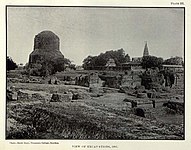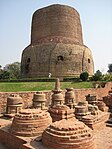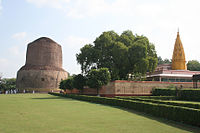Dhamek Stupa
Dhamek Stupa (also spelled Dhamekh and Dhamekha) is a massive stupa located at the archaeological site of Sarnath in the state of Uttar Pradesh, India.
Dhamek Stupa marks the precise location where the Buddha preached his first discourse to his first five disciples (Kaundinya, Assaji, Bhaddiya, Vappa and Mahanama), and where all five eventually became fully liberated.
| Dhamek Stupa धमेख स्तूप (in Hindi) | |
|---|---|
 | |
| Religion | |
| Affiliation | Buddhism |
| Status | Preserved |
| Location | |
| Location | |
| Administration | Archaeological Survey of India |
| Geographic coordinates | 25°22′51″N 83°01′28″E / 25.3808°N 83.0245°E |
| Architecture | |
| Type | Stupa |
| Style | Buddhist, Mauryan art |
| Completed | 5th-6th century AD |
| Specifications | |
| Length | 28 metres (92 feet) |
| Width | 28 metres (92 feet) |
| Height (max) | 43 metres (141 feet) |
| Materials | white makrana marble |
Etymology
The name Dhamek derives from the Sanskrit word dharmeksā, which means "pondering of the law" in the Sanskrit language.
Location
Dhamek Stupa is located 180 metres (590 feet) to the east of Dharmarajika Stupa at the archaeological site of Sarnath. Sarnath is located 12 kilometres (7.5 miles) to the northeast of Varanasi, in Uttar Pradesh, India.
Description
Dhamek Stupa is the most massive structure in Sarnath. In its current shape, the stupa is a solid cylinder of bricks and stone reaching a height of 43.6 meters and having a diameter of 28 meters. The basement seems to have survived from Ashoka's structure, while the stone facing displays delicate floral carvings characteristic of the Gupta era. The wall is covered with exquisitely carved figures of humans and birds, as well as inscriptions in Brahmi script. The stupa was enlarged on six occasions but the upper part is still unfinished. While visiting Sarnath in 640 CE, Xuanzang recorded that the colony had over 1,500 priests and the main stupa was nearly 300 feet (91 m) high.
An Ashoka pillar with an edict engraved on it stands near the site.
History
Dhamek Stupa marks the precise location where the Buddha preached his first discourse to his first five disciples (Kaundinya, Assaji, Bhaddiya, Vappa and Mahanama), and where all five eventually became fully liberated. This event marked the formation of the sangha. Several of the ancient sources describe the site of this first sermon as a Mriga-dayaa-vanam or a sanctuary for animals. (In Sanskrit, the word mriga is used in the sense of game animals, with deer being the most common).
After the parinirvana of the Buddha in 544 BCE, his remains were cremated and the ashes were divided and buried under eight stupas, with two further stupas encasing the urn and the embers. Dhamek Stupa was presumably among these eight stupas, and Mauryan King Ashoka may have commissioned its expansion. But the current Dhamek Stupa, as visible today, was conclusively dated to the Gupta period, in the 5th-6th century CE.
A 17th-century Jain manuscript describes a Jain temple in Varanasi as a pilgrimage site for Jains. The temple is located close to "a famous Bodisattva sanctuary" at a place called dharmeksā.
In what is the first incontrovertible reference to the ruins at Sarnath, Jonathan Duncan (a charter member of the Asiatic Society and later Governor of Bombay) described the discovery of a green marble reliquary encased in a sandstone box in the relic chamber of a brick stupa at that location. The reliquary was discovered in January 1794, during the dismantling of a stupa (referred to by Alexander Cunningham as stupa "K" or the "Jagat Singh stupa", later identified as the Dharmarajika Stupa) by employees of Zamindar Jagat Singh (the dewan of Maharaja Chait Singh, the Raja of Benares). Duncan published his observations in 1799. The reliquary contained a few bones and some pearls, which were subsequently thrown into the Ganges river. The reliquary itself has also disappeared, although the outer sandstone box was replaced in the relic chamber, where it was rediscovered by Cunningham in 1835. The bricks of the stupa were hauled off and used for the construction of the market in Jagatganj, Varanasi. Jagat Singh and his crew also removed a large part of the facing of the Dhamek Stupa, and removed several Buddha statues which he retained at his house in Jagatganj.
Gallery
- As it appeared in 1814
- As it appeared in 1891
- As it appeared in 1905. Camera angle from the ruins of the ancient Mulagandha Kuty Vihara towards the Dhamek Stupa; the Sri Digamber Jain temple can be seen on the right side of the photograph.
- As it appeared in 2008
- Dhamekh Stupa wall close-up, as it appeared in 2008
- As it appeared in 2009
- As it appeared in 2009 (close-up view)
- Plaque at Sarnath historical site, outlining the history of Dhamekh Stupa (2010)
- As it appeared in 2019. Camera angle from the ruins of the ancient Mulagandha Kuti Vihar towards the Dhamek Stupa; the Shreyanshnath Jain Temple can be seen on the right side of the photograph (the Panchayatan Temple can also be seen in the middle).
- As it appeared in 2023. Camera angle from the far north of the ruins.
References

This article uses material from the Wikipedia English article Dhamek Stupa, which is released under the Creative Commons Attribution-ShareAlike 3.0 license ("CC BY-SA 3.0"); additional terms may apply (view authors). Content is available under CC BY-SA 4.0 unless otherwise noted. Images, videos and audio are available under their respective licenses.
®Wikipedia is a registered trademark of the Wiki Foundation, Inc. Wiki English (DUHOCTRUNGQUOC.VN) is an independent company and has no affiliation with Wiki Foundation.











